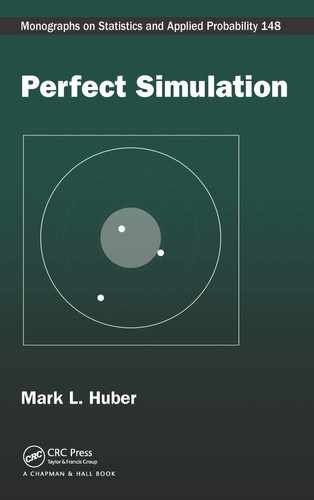
List of Figures
1.1 Written in binary, an actu a l uniform over [0,1] contains an infi-
nite sequence of bits, each of which is uniform over {0,1}.Any
computer-generated randomness only contains a finite number of
such bits. 22
2.1 Acceptance/rejection draws from the larger set B until the result falls
in th e smaller set A.Thefinal point comes from the distribution over
B conditioned to lie in A.26
2.2 To draw X with de nsity f ,draw(X,Y ) uniformly from the region
under the density, then throw away the Y value. This procedure
works whether or not the density is normalized. 27
2.3 Drawing uniformly from the union of three circles of equal area.
First draw I uniformly from {1 , 2, 3}, then the point X uniformly
from circle I. Finally, accept X with proba bility 1 over the number
of circles that X falls into. In this example, circle 2 in the lower
right was chosen, then the point X that was uniform over this circle
falls into two of the circles, so it would be accepted as a draw with
prob ability 1/2. 31
3.1 A completely coupled set of processes. X (represented by squares)
and Y (represented by circles) are simple symmetric random walks
with partially reflecting boundaries on Ω = {0,1,2}. They have
coupled at time t = 3. 44
3.2 The slice sampler dividing up the state space. Note that since y <
y
,
it holds that A(y
) ⊆A(y). In this example, the draw X
y
∼Unif(A(y))
did not land in A(y
), so an independent choice of X
y
∼ Unif (A(y
))
was simulated. 56
4.1 The permutation x =(3,1,2,4) (so x
−1
=(2,3,1,4)) illustrated as a
rook placement. The bounding state y =(2,4,4,4) is shown as gray
shaded squares. 68
6.1 The density of X
t+1
given that X
t
= 0.3, which is (1/2)1(x ∈
[0,1])+ (1/2)1(x ∈ [0,0.6]).98
xvii
xviii LIST OF FIGURES
6.2 First generate Z ∼ f ,then[Y |Z] ∼ Unif([0, f (Z)]). Finally, draw
W ∼Unif({x : f (x) ≥Y}).ThenW ∼ Z.Inthefigure, the state space
for the draw W is the dashed line. 102
6.3 Inverting the right half of the normal density. Z is still drawn from
f ,now[Y |Z] is uniform over the area between the two lines with
horizontal coordinate Z.ThenW is uniform over the shaded area
with vertical coordinate Y . Now the state space of W is an in terval
of length at least 2 .35. 103
6.4 Interwoven vectors: r =(0.25,0.1,0.6,0.75), s =(0.3,0.2,0.7
,0.9),
and
σ
=(2, 1,3,4). 115
6.5 If
δ
1
and
δ
2
are at most 1/(8n
2
),and
δ
3
> 1/(4n
2
),thenx
min
(
σ
(i +
1)) > x
max
(
σ
(i)). 119
8.1 The density of X
2
for simple symmetric random walk on {1, 2,...,n}
conditioned on X
0
= 1 . The dotted line shows th at this density is
actually a mixture of the uniform distribution over {1} with the
uniform distribution over {1,2,3}. 143
9.1 Illustration o f Lemma 9.6. The figures plot the right-hand side of
Equation (9.23) minus the left-hand side. The inequality is actually
a strict inequality everywhere except when r = a = 1. 169
10.1 Generating the passage times gives an upper and lower bound on
the Brownian motion. The Brownian motion must pass through the
circles and stay in the gray shaded area. 196
11.1 A single run of TPA when B is the ball of radius 3, A is the ball
of radius 1, and B
β
is the ball of radius
β
. The number of samples
needed before X lands in the center is 3, giving output N = 2. 202
11.2 Matern type III process where R = 0.35, dist(a,b)=0.3, dist(a, c)=
0.4, dist(b,c)=0.5, t
a
= 0.63, t
b
= 0 .87, t
c
= 0.22. Point c is born
first, then a,butb is not because it is too close to a. 205
11.3 Example of a shadow region for S =[0,10], x
1
= 2.8, x
2
= 5.2,
x
3
= 8.0, t
1
= 0.5, t
2
= 0.65, t
3
= 0.7, R = 1.4. If there are only
hidden points in the shadowed region, they will not be seen at time
1. 206
..................Content has been hidden....................
You can't read the all page of ebook, please click here login for view all page.
